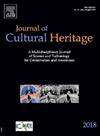The potential of applying soft capping approach on earthen and masonry built heritage
IF 3.5
2区 综合性期刊
0 ARCHAEOLOGY
引用次数: 0
Abstract
Cultural heritage sites worldwide are increasingly threatened by deterioration due to natural erosion and the intensified effects of climate change. Soft capping, an environmentally friendly approach for protecting built heritage using plants, has been underexplored from a biological perspective. This article aims to review studies on soft capping applied to earthen and masonry heritage from the 1980s to the present. The findings categorise soft capping into four types: Phototropic biofilms- and Lichen-capping, Bryophyte-capping, Spermatophyte-capping and Mixed plants-capping. The selection of soft capping type depends on the site's microclimates, building materials and the structure's geometry. Soft capping helps to regulate the microclimates of affected structures, slowing deterioration and enhancing their long-term sustainability. Additionally, it offers flexible adaptation to individual cases for optimal protection. Despite the considerable benefits of soft capping, further research and expanded databases are necessary to better understand factors such as type selection, composition, protective efficacy and limitations. This knowledge will enable more informed conservation strategies for applying soft capping to heritage sites in the future.
软封顶法在土石建筑遗产上的应用潜力
由于自然侵蚀和气候变化的影响加剧,世界各地的文化遗产日益受到退化的威胁。软盖是一种利用植物保护建筑遗产的环保方法,从生物学的角度来看,这一方法尚未得到充分的探索。本文综述了20世纪80年代以来软盖技术在土工和砌体遗产中的应用。研究结果将软盖层分为四种类型:嗜光生物膜和地衣盖层、苔藓植物盖层、精子植物盖层和混合植物盖层。软盖类型的选择取决于场地的微气候、建筑材料和结构的几何形状。软封顶有助于调节受影响结构的小气候,减缓恶化并提高其长期可持续性。此外,它提供灵活的适应,以实现最佳保护的个别情况。尽管软封顶有相当大的好处,但需要进一步的研究和扩展数据库,以更好地了解诸如类型选择、成分、保护效果和局限性等因素。这些知识将使未来对遗产地点实施软封顶的保护策略更加明智。
本文章由计算机程序翻译,如有差异,请以英文原文为准。
求助全文
约1分钟内获得全文
求助全文
来源期刊

Journal of Cultural Heritage
综合性期刊-材料科学:综合
CiteScore
6.80
自引率
9.70%
发文量
166
审稿时长
52 days
期刊介绍:
The Journal of Cultural Heritage publishes original papers which comprise previously unpublished data and present innovative methods concerning all aspects of science and technology of cultural heritage as well as interpretation and theoretical issues related to preservation.
 求助内容:
求助内容: 应助结果提醒方式:
应助结果提醒方式:


